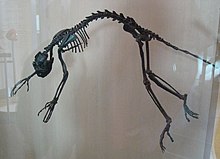Adapiformes
| Adapiformes | |
|---|---|

| |
| Notharctus tenebrosus | |
| Scientific classification | |
| Kingdom: | |
| Phylum: | |
| Class: | |
| Order: | |
| Infraorder: | Adapiformes Hoffstetter, 1977
|
| Families (extinct) | |
Adapiformes are an extinct group of primitive primates. The adapiformes radiated throughout much of the northern continental mass, reaching as far south as northern Africa and tropical Asia. The adapiformes existed from the Eocene epoch to the Miocene epoch. Most of the adapiformes looked similar to living lemurs.
The adapiforms are known from the fossil record only, and it is unclear whether they form a monophyletic or paraphyletic group. When assumed to be a clade, they are usually grouped under the "wet-nosed" taxon Strepsirrhini, which would make them ancestral to the lemurs, but not to the "dry-nosed" Haplorrhini taxon that includes monkeys and apes.[1]
Franzen et al. (2009) place the newly-described Darwinius genus in the "Adapoidea group of early primates representative of early haplorhine diversification" so that, according to these authors, the adapiforms would not be within the Strepsirrhini lineage as hitherto assumed but qualify as a stem "missing link" between Strepsirrhini and Haplorrhini.[2] However, subsequent analysis on the Darwinius fossil by Erik Seiffert, et al rejects this "missing link" theory, classifying Darwinius within the Strepsirrhini.[3]
Classification
See also List of fossil primates
- Family Notharctidae
- Subfamily Cercamoniinae
- Genus Anchomomys
- Genus Buxella
- Genus Darwinius
- Genus Donrussellia
- Genus Europolemur
- Genus Mahgarita
- Genus Panobius
- Genus Periconodon
- Genus Pronycticebus
- Subfamily Notharctinae
- Genus Cantius
- Genus Copelemur
- Genus Hesperolemur
- Genus Notharctus
- Genus Pelycodus
- Genus Smilodectes
- Subfamily Cercamoniinae
- Family Sivaladapidae
- Genus Kyitchaungia
- Genus Paukkaungia
- Genus Siamoadapis
- Genus Sivaladapis
- Family Adapidae
- Genus Adapis
- Genus Adapoides
- Genus Afradapis
- Genus Leptadapis
- Genus Godinotia
- Family Incertae sedis
- Genus Omanodon
- Genus Muangthanhinius
- Genus Lushius Chow, 1961
- Genus Panobius
- Genus Djebelemur
- Genus Omanodon
- Genus Shizarodon
References
- ^ Callum Ross, Richard F. Kay, Anthropoid origins: new visions, Springer, 2004, ISBN 9780306481208, p. 100
- ^ Franzen, Jens L. (2009). "Complete Primate Skeleton from the Middle Eocene of Messel in Germany: Morphology and Paleobiology". PLoS ONE. 4 (5): e5723. doi:10.1371/journal.pone.0005723. PMC 2683573. PMID 19492084.
{{cite journal}}: Cite has empty unknown parameter:|month=(help); Unknown parameter|coauthors=ignored (|author=suggested) (help)CS1 maint: unflagged free DOI (link) - ^ Ritter, M. (October 21, 2009). "Primate fossil called only a distant relative". Associated Press. Retrieved 2009-10-22. [dead link]
This article includes a list of references, related reading, or external links, but its sources remain unclear because it lacks inline citations. (June 2009) |
- Beard, K. C., L. Marivaux, S. T. Tun, A. N. Soe, Y. Chaimanee, W. Htoon, B. Marandat, H. H. Aung, and J.-J. Jaeger. 2007. New silvaladapid primates from the Eocene Ponduang Formation of Myanmar and the anthropoid status of Amphipithecidae. Bulletin of Carnegie Museum of Natural History, 39:57-65.
